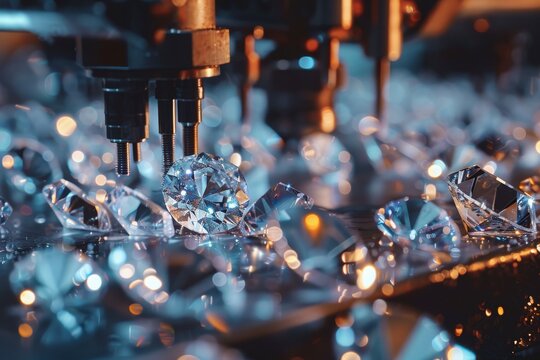Introduction to Lab Grown Diamonds
When you think of diamonds, what comes to mind? Are you picturing the rare, natural gemstones that have long been considered the epitome of luxury and love? Well, it’s time to open your mind to a new contender in the diamond world: lab grown diamonds. These marvels of modern technology are not just changing the way we think about diamonds—they’re also reshaping the market and challenging traditional notions of what a diamond can be.
What Are Lab Grown Diamonds?
Lab grown diamonds, as the name suggests, are diamonds that are created in a laboratory setting rather than being mined from the earth. They have the same physical, chemical, and optical properties as natural diamonds. Essentially, they’re the real deal, just with a different origin story. Unlike their natural counterparts, which are formed over billions of years under the Earth’s crust, lab grown diamonds are produced in weeks or months using advanced technology.
How Do Lab Grown Diamonds Differ from Natural Diamonds?
So, you might be wondering—what’s the catch? How do these lab grown diamonds stack up against natural ones? Well, here’s the scoop: lab grown diamonds are chemically identical to natural diamonds. They’re both made of carbon atoms arranged in a crystal lattice structure. The main difference lies in their origin. Natural diamonds are formed deep within the Earth under intense pressure and heat, while lab grown diamonds are created using specific techniques that replicate these conditions in a controlled environment.
The Science Behind Lab Grown Diamonds
Let’s dive into the nitty-gritty of how these diamonds are made. It’s pretty fascinating stuff, and it gives you a glimpse into the science that’s making these gems more accessible than ever before.
High Pressure High Temperature (HPHT) Method
One of the methods used to create lab grown diamonds is the High Pressure High Temperature (HPHT) method. This technique mimics the natural conditions under which diamonds are formed. In a high-pressure, high-temperature press, carbon is subjected to extreme pressure and heat, turning it into a diamond. Think of it as creating a diamond in a pressure cooker!
Chemical Vapor Deposition (CVD) Method
Another popular method is Chemical Vapor Deposition (CVD). This process involves placing a diamond seed in a chamber filled with carbon-rich gases. The gases are then ionized, and the carbon atoms deposit onto the seed, layer by layer, eventually forming a diamond. It’s like growing a diamond crystal from scratch using a very sophisticated 3D printer.
Benefits of Lab Grown Diamonds
Why are people flocking to lab grown diamonds? It’s not just because they’re trendy. There are several compelling benefits that make them a standout choice.
Ethical and Environmental Impact
One of the biggest advantages of lab grown diamonds is their ethical and environmental impact. Traditional diamond mining often involves harsh labor conditions and significant environmental damage. In contrast, lab grown diamonds are produced in a controlled setting, reducing the ecological footprint and ensuring fair labor practices. For many, this ethical edge is a major draw.
Cost Efficiency
Lab grown diamonds also offer considerable cost savings. Because they’re created in a lab rather than mined from the earth, they’re generally less expensive. This means you can get a larger or higher-quality diamond for the same price as a smaller or lower-quality natural diamond. It’s a win-win!
Quality and Purity
When it comes to quality, lab grown diamonds are top-notch. They often surpass natural diamonds in terms of purity because they’re grown in a controlled environment where impurities are minimized. Plus, they undergo the same grading processes as natural diamonds, so you can expect a gem that shines just as brightly.
Popular Uses for Lab Grown Diamonds
Lab grown diamonds aren’t just for engagement rings and jewelry; they’re making waves in various industries.
Engagement Rings
The engagement ring market has seen a significant shift towards lab grown diamonds. Couples are increasingly choosing these gems for their ethical and cost benefits. A lab grown diamond engagement ring offers all the sparkle and sentiment of a natural diamond but with a modern twist.
Fashion Jewelry
Fashionistas are also embracing lab grown diamonds. Whether it’s a trendy necklace, chic earrings, or a dazzling bracelet, lab grown diamonds are becoming a popular choice for those who want to make a statement without compromising on ethics.
Industrial Applications
Beyond the world of jewelry, lab grown diamonds have practical applications in industries like cutting, grinding, and drilling. Their hardness makes them ideal for these purposes, and using lab grown diamonds in these applications can be more cost-effective than using natural ones.
How to Choose the Right Lab Grown Diamond
Choosing a lab grown diamond can be just as thrilling (and challenging) as picking a natural one. Here’s what you need to know to make the right choice.
Understanding the 4 Cs
Just like natural diamonds, lab grown diamonds are graded based on the 4 Cs: Cut, Color, Clarity, and Carat weight. Understanding these factors will help you choose a diamond that meets your preferences and budget. Whether you want a diamond with a perfect cut or one with minimal inclusions, knowing the 4 Cs will guide your decision-making process.
Certifications and Guarantees
When purchasing a lab grown diamond, it’s essential to look for certifications from reputable gemological laboratories. These certifications ensure the authenticity and quality of the diamond. Also, check for guarantees or warranties from the seller to protect your investment.
The Market Trends and Future Outlook
The lab grown diamond industry is evolving rapidly. Here’s a peek into the current trends and what the future might hold.
Growing Popularity
Lab grown diamonds are gaining traction as more people become aware of their benefits. As technology advances and production costs decrease, these diamonds are likely to become even more popular. The shift towards sustainable and ethical practices is also fueling their rise.
Technological Advancements
Ongoing advancements in technology are making it easier and more cost-effective to produce lab grown diamonds. From improved growth techniques to enhanced grading systems, these innovations are contributing to the growing appeal of lab grown diamonds.
Conclusion
Lab grown diamonds represent a fascinating intersection of science, ethics, and luxury. As they continue to gain popularity, they offer a fresh perspective on what a diamond can be. Whether you’re drawn to their ethical advantages, cost-effectiveness, or sheer brilliance, lab grown diamonds are undeniably making their mark. So next time you’re in the market for a dazzling gem, consider the future of sparkle with lab grown diamonds. After all, why not choose a gem that shines brightly in every sense?



